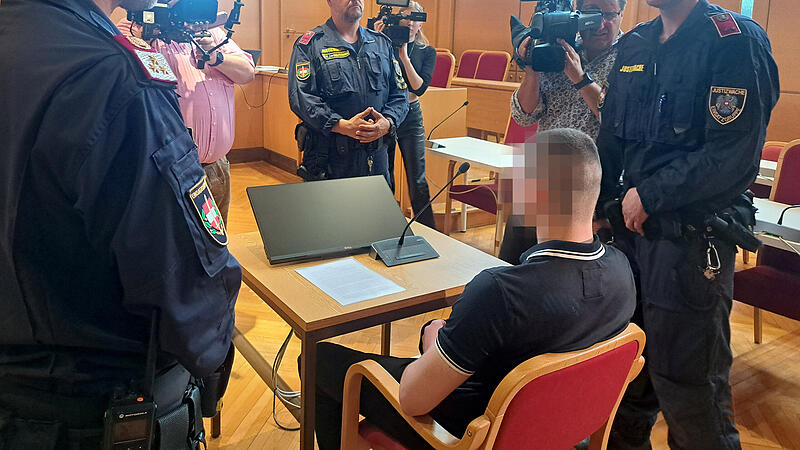Image: VERENA LEISS (APA)
A 19-year-old who is said to have killed a peer with snow poles in February was sentenced to 18 years in prison for murder in Linz on Thursday. He is also admitted to a forensic therapy center because an expert opinion had attested to him being dangerous and a risk of recurrence. The judgment is final.
The jury found him unanimously guilty of murder and attempted burglary. As a young adult, the 19-year-old faced ten to 20 years in prison, but there is no such thing as life imprisonment in this age group. 18 years were imposed. In view of the brutality of the act, “nothing else was conceivable than the upper limit of the penalty range,” said the chairman of the jury in the verdict. The claims made by private parties were correspondingly high: the accused had to pay the relatives a total of 145,000 euros in compensation for pain and suffering as well as the funeral costs.
A look back at the day of the trial
The jury room is filled to capacity as Samuel Z. takes his place in the dock. He is surrounded by law enforcement officers and cameramen. The 19-year-old holds an A4 note in his hands. He refuses to answer questions. Instead, he is making a statement, a brief explanation of what happened on the night of February 12th.
“I dare to try to apologize honestly, even if there is no excuse for it,” he reads. He takes “full responsibility” and not a day goes by that he doesn’t have to think about the “fatal evening”. He attributes his – as he says, “instantaneous action” – to “a hodgepodge of circumstances” such as the consumption of “substances”, alcohol and medication as well as a gambling addiction. “I ask for a lenient sentence and will not answer any further questions,” the defendant said in closing. When asked by the judge whether these were his own, Samuel Z answered in the affirmative.
Opinion: Sane and dangerous
As reported, he is said to have hit his friend (19) on the way home from a casino in the Czech Republic and then killed her with two snow sticks. The next morning, a driver found the student’s body on a forest path in Bad Leonfelden. “Stefanie’s agony lasted half an hour,” the judge read from the file.
Forensic psychiatrist Adelheid Kastner examined the young man. She sees a pathological gambling addiction just as little as schizophrenia, from which the accused always claimed to suffer. In her report, she certifies that the 19-year-old has a narcissistic personality disorder and the danger that he could commit similar acts again. If he gets angry, serious bodily harm up to homicide is to be feared. A prognosis tool based on the behavior of criminals classified the accused in the sixth of seven risk categories.
Regarding the accused act, he told her that he “wanted to finish it” because he was afraid the 19-year-old might report him after he had hit her. He even asked whether it might not have been self-defense to kill the woman because she had fought so hard. “He bathes in self-pity. That’s the typical attitude of the narcissist.”
Kastner described the accused’s problematic childhood with a seriously mentally ill mother. Due to his history and not very high intelligence, he failed at several training places and began to “take on the role of the victim”. Last year he went to a psychiatrist and said he heard voices. The doctor had expressed the suspicion that schizophrenia could develop, but she did not make a diagnosis, Kastner emphasized, and the accused then stopped attending. However, he told those around him that he suffered from schizophrenia, “which is actually not the case”, but that enabled him not to have to work. In view of his money problems, he developed the obsession of being able to hit the jackpot in the casino.
Not legally possible for life
If Samuel Z. is convicted, he faces ten to 20 years in prison. Lifetime doesn’t exist in his age group. In addition to a conviction, the public prosecutor also wants a briefing in a forensic therapeutic center. A verdict could fall as early as the evening.
At the beginning of the trial, Samuel Z.’s defense attorney files a motion to exclude the public. It’s about “the highly personal area of life and the psyche of the accused,” he said. The court does not grant the application. The audience can remain in the hall. What awaits them is “strong stuff,” warns coroner Harald Meyer. “There are so many injuries that I don’t know where to begin,” he says, looking at the video screen provided.
He reports numerous injuries to the head, neck and chest from massive kicks and deep stabs with a blunt cylindrical object, probably a snow pole. He himself had never seen such an accumulation of blunt force injuries that penetrated so deeply into the body, said the deputy head of the Salzburg forensic medicine. The defendant looks away from the illustrated lecture.
What happened on the night of the murder and the day after
Before that, the prosecutor read the indictment. It was four in the morning when Samuel and Stefanie drove to a forest near the Sternstein ski area. After intimacy, both got out of the BMW. The then 18-year-old took a snow pole and started playing with it. A quarrel ensued. According to the indictment, the young man was upset because he had lost money at the casino. “Suddenly he got so angry that he hit his girlfriend in the neck and head with the pole,” the prosecutor reads from the file.
There must have been a real fight where the student wanted to flee by car, but got stuck in a snowdrift. The boy is said to have killed her with a second snow pole.
The accused was then on the way home at a gas station, where he justified his bloody clothes with a wildlife accident, the prosecutor described. At home the next day he said he was going to the police station. There he had an appointment after an attempted break-in into a farm shop, for which he is also accused. Instead, however, he drove into a forest and disposed of the dead’s belongings and bloodied clothing that had been left in his car.
Prosecutor: Defendant had intent to kill
The then 18-year-old told the police that he wanted to “sell the car for export” as quickly as possible and flee to Canada, having already looked for flights. The fact that he then turned himself in was thanks to the urging of his brother, to whom he had confessed the crime. It is clear to the prosecutor that the accused had an intention to kill, which he finally admitted himself.
He has “nothing to oppose” the prosecution, said the defense attorney, and his client will assume full responsibility.
The OÖN are on site during the process, the article is continuously updated.
Source: Nachrichten




